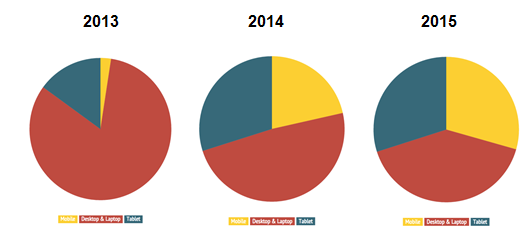Google’s cellular-pleasant Algorithm update in a Multi-Screening World
April 21, 2015
We’re all aware of Google’s constant algorithm updates. From the Penguin, to the Panda, all over to the Hummingbird, these updates incessantly result in entrepreneurs to panic into thinking that their web sites will probably be penalized, however in a roundabout way lead to a cleaner and more related search experience for customers.
And the most recent algorithm replace isn’t any different. It doesn’t have an exhilarating title like Panda or Penguin just yet (although some are amusingly regarding it as ‘mobilegeddon’) nevertheless it’s prone to have a in a similar fashion vital, and certain, effect, with search expertise on cell set to vastly make stronger.
In a publish on the Google Webmaster weblog on February 26th 2015, Google introduced it’ll commence the use of cell usability as a ranking think about its search outcomes from April 21st, giving webmasters plenty of time to verify their website online is as much as same old.
in the blog submit, Google stated:
“we will be able to be expanding our use of cell-friendliness as a rating sign. this modification will impact cell searches in all languages worldwide and could have a big impact in our search results.”
fundamentally, If manufacturers or their agencies don’t react to the replace quickly or successfully, they might find their consumers connecting with their competitors instead.
Why did Google introduce this update?
It’s a well timed update in fact, as we know that cellular internet shopping is repeatedly on the rise. more specifically, in an generation the place multi-screening is growing, it has grow to be not simply necessary but crucial for manufacturers to have a great cell presence.
recent data from Mintel displays that forty one% of customers are actually procuring by the use of smartphones and 35% by the use of pills, and our multi-screening habits are simplest getting more desirable as this text signifies. As the use of cellular units to browse and search increases, it becomes extra important for serps to offer users outcomes that deliver the very best expertise on smaller displays.
a quick take a look at fast internet Media website online analytics displays how fast mobile search site visitors has grown within the closing two years:

The diagrams above convey that handiest forty% of the search traffic in 2015 used to be from computer and computer units. the remaining is from mobiles and tablets– representing around 30% each and every. Rewind again to 2013, and eighty two.6% arrived by way of pcs, and simply 2.four% by the use of mobile.
mobile search engine visitors for the web page above has elevated by means of 1,422% in simply two years whereas computer visitors, over the identical period of time, has diminished by 38.2%. The numbers discuss for themselves with many other internet sites showing an identical figures over the last two years as well.
With this degree of growth in cellular usage, Google is looking to reward websites that supply a just right experience, and let websites with negative mobile experience recognize that they’ll need to restore their site prior to they are able to expect excellent site visitors and rankings in Google Search results.
What we learn about multi-screening
here at quick internet Media, we’ve been taking a look into multi-screening trends on the grounds that 2013, as it become evident that this development would most effective grow and that increasingly brands would remember and adopt suave multi-monitor strategies. keeping an in depth eye on developments, we’ve learnt some essential lessons along the way that cement our perception in making the offline and the online seamlessly connected.
we all know that people multi-display; in reality information from Kantar tells us that Brits are regularly using up to 5 gadgets simultaneously, which is awesome. in fact, we also recognize that television evokes individuals to go looking, either to find out extra about what they’re watching or to reply to a television advert or content material and search for the product mentioned. In different words, tv and cellular are heavily used together, which is why we see so many T.V. ads placing social media calls to motion or site URLs at the end of an advert, calling for people to attach with the logo on-line. actually, one in all our contemporary blog articles discusses the advantages of cell for e-commerce brands.
then again, it’s necessary to notice in this state of affairs that cell is incessantly where the user experience starts, however now not all the time the place it ends, i.e. no longer necessarily where the conversion occurs. via analysis, we’ve discovered that mobile is often the starting segment on a consumer’s trip, used to find out more knowledge and make comparisons with an identical merchandise or manufacturers. on the other hand, the ride is often endured at a later time on a different instrument, mainly a desktop software. So those manufacturers that still don’t have a mobile-friendly site will in finding that they’re now not simply missing out on the mobile users, but in addition those guests who would start their experience on a cell and convert on a special device. So now not having a cellular optimised website has wider implications that just missing out on one of the vital cellular traffic.
as an example, a model like Vanish or Cillit Bang, with huge tv budgets in location for promoting area, will in finding that their on-line and offline worlds aren’t as seamlessly connected as they should be. these of us sitting on the sofa, who see a type of Vanish Oxy action ads with the to hand cleansing guidelines could come to a decision to search online for more data. If searching by the use of our smartphones, which is the perhaps scenario, we’ll be confronted with this:

A web page that’s difficult to see on a mobile and doesn’t pass Google’s cell pleasant test. textual content is too small, links are too shut together, and the content is wider than the monitor. these guests with just a little bit of persistence may spend some time zooming inside and out and looking for what they want, however many will merely hand over, inflicting the manufacturers to lose some very precious visitors. The websites seem to be nice on a laptop, however now not so nice on a mobile monitor.
So what is Google searching for in a ‘cell-friendly’ website?
there has been no reliable announcement made on the specifics at the back of the algorithm, however Google is very clear on perfect-observe tips from a cell viewpoint.
Any website online can check how cell friendly it is in Google’s eyes with Google’s mobile friendly test. This appears to be like at the total design of a website and how it appears to be like on a cellular tool, taking into consideration the dimensions of the textual content, the way it suits on a mobile monitor, whether or not there’s enough space for customers to click on on the links etc. offering rapid feedback on anything else that doesn’t go the check and should due to this fact be actioned.
Any web site that passes the check additionally presentations up with a ‘cellular friendly’ label in Google’s cell search results – an awfully public indication of high quality that provides even more purpose to get on board with cellular. extra details about Google’s mobile pleasant check will also be discovered on this article.
Over to you
the growth in cellular is nothing new, and it’s in no way one thing that manufacturers must best now be serious about. Google has been telling site owners to organize for cell for a while now, however with this algorithm update, it ultimately gives those manufacturers which have been lagging behind a compelling purpose to take motion.
Digital & Social Articles on industry 2 group
(163)














